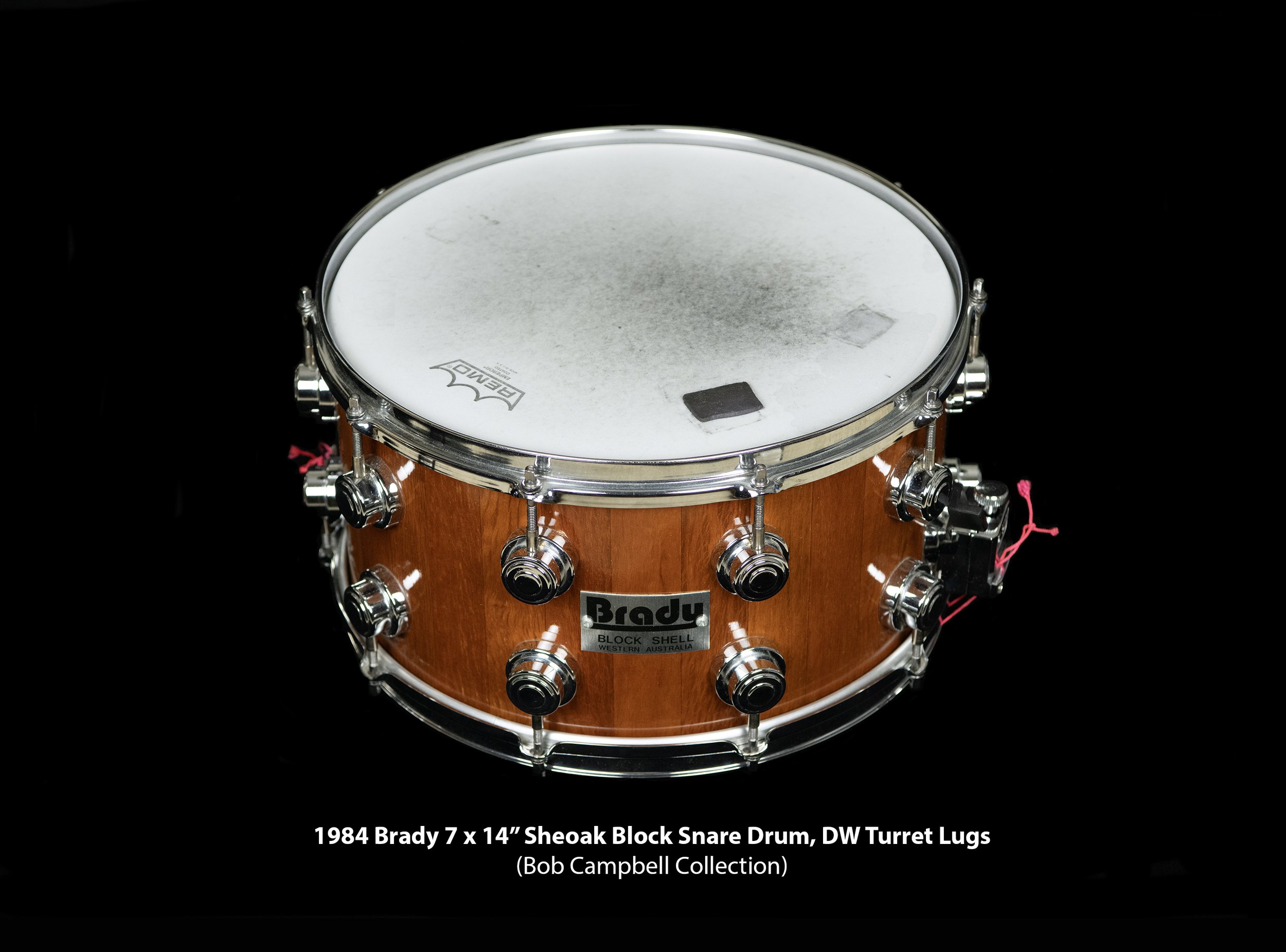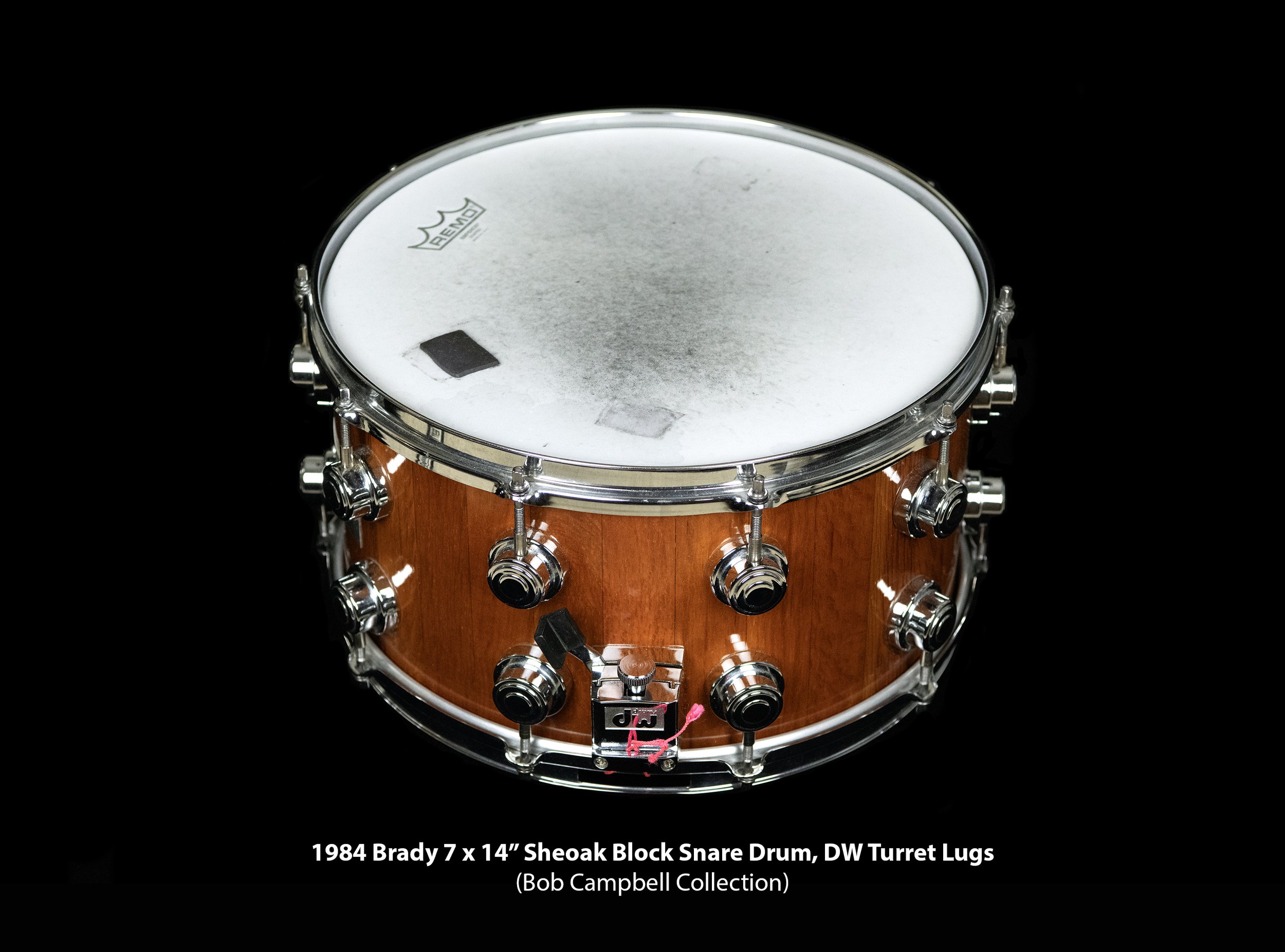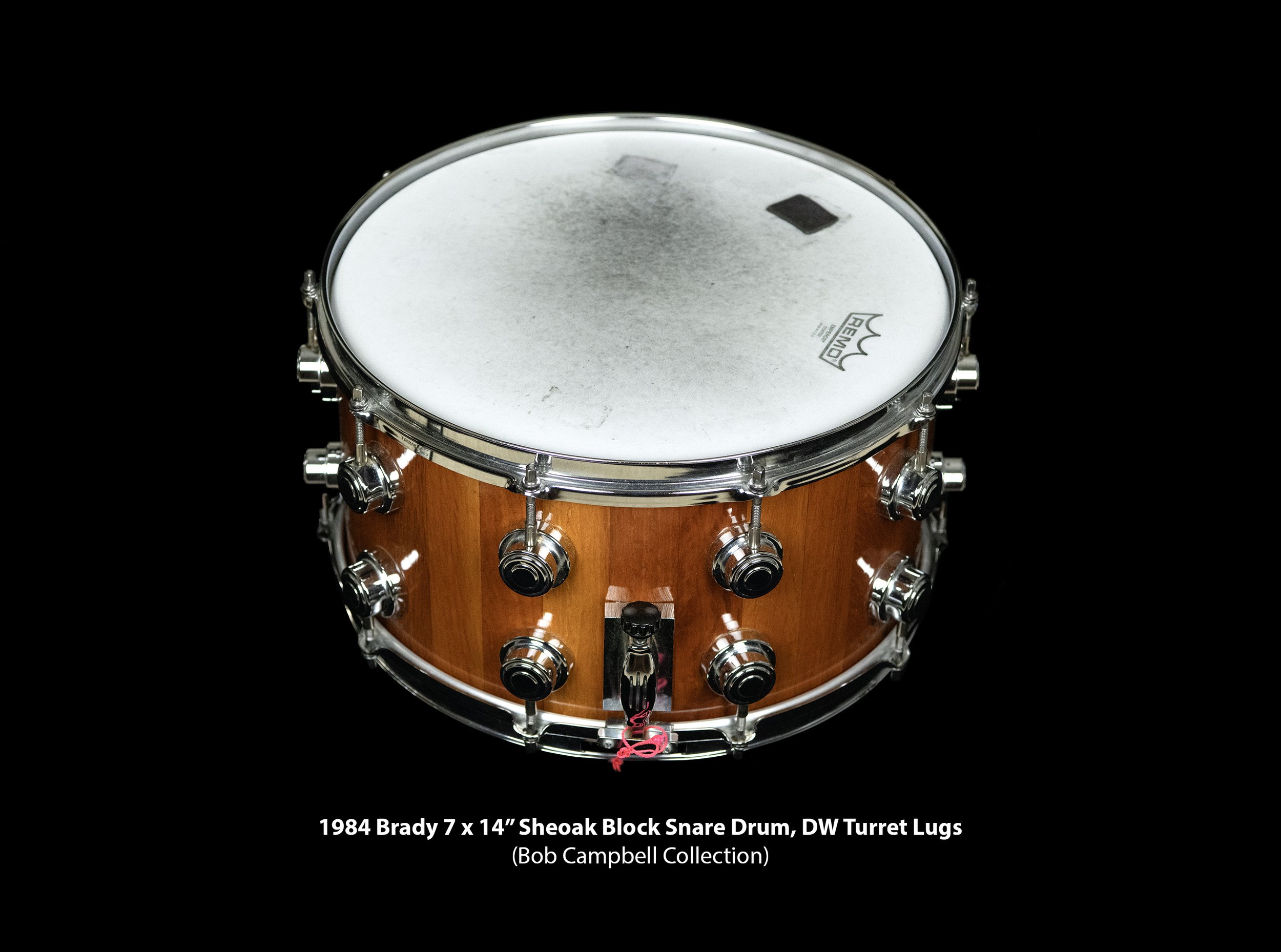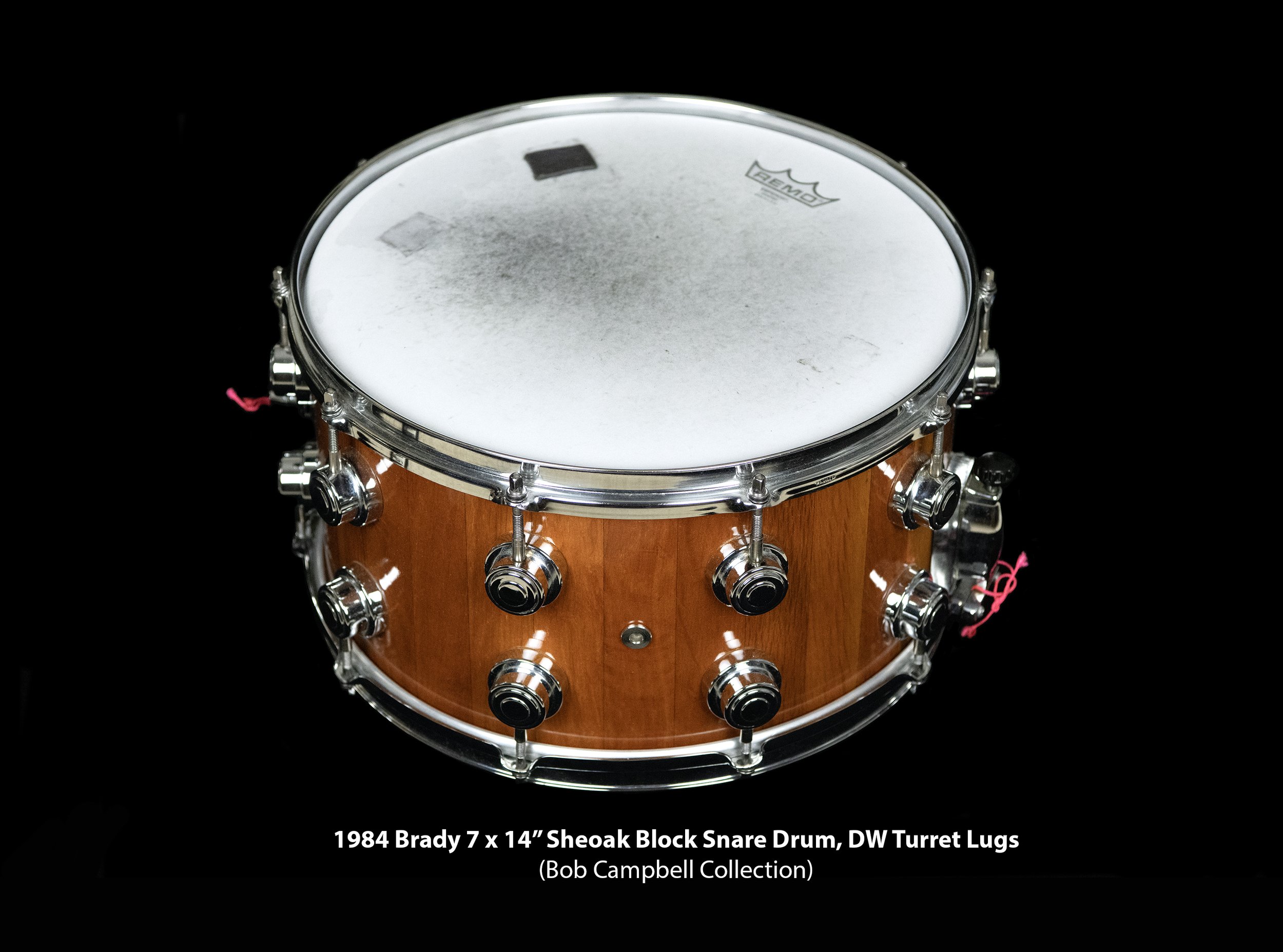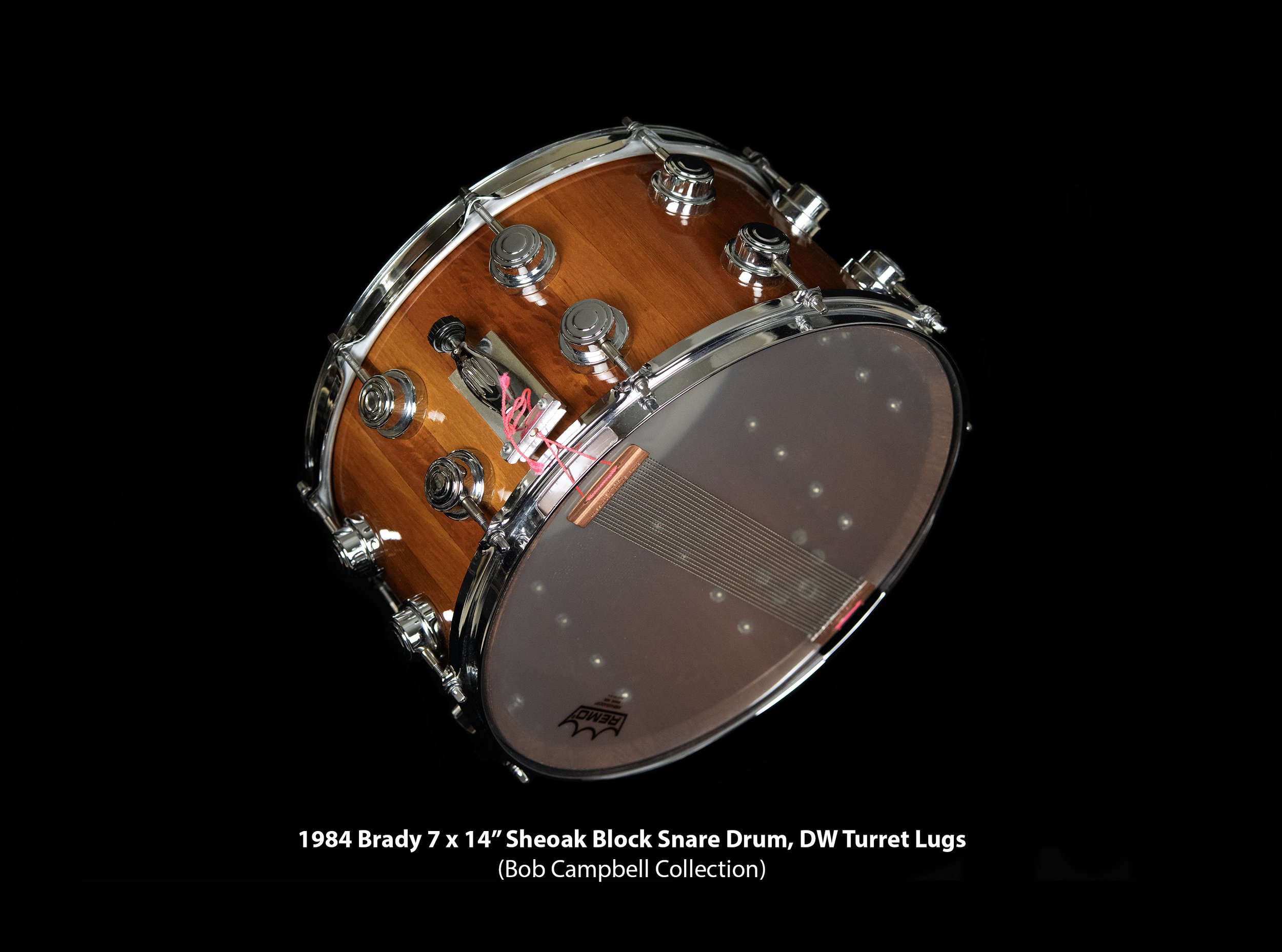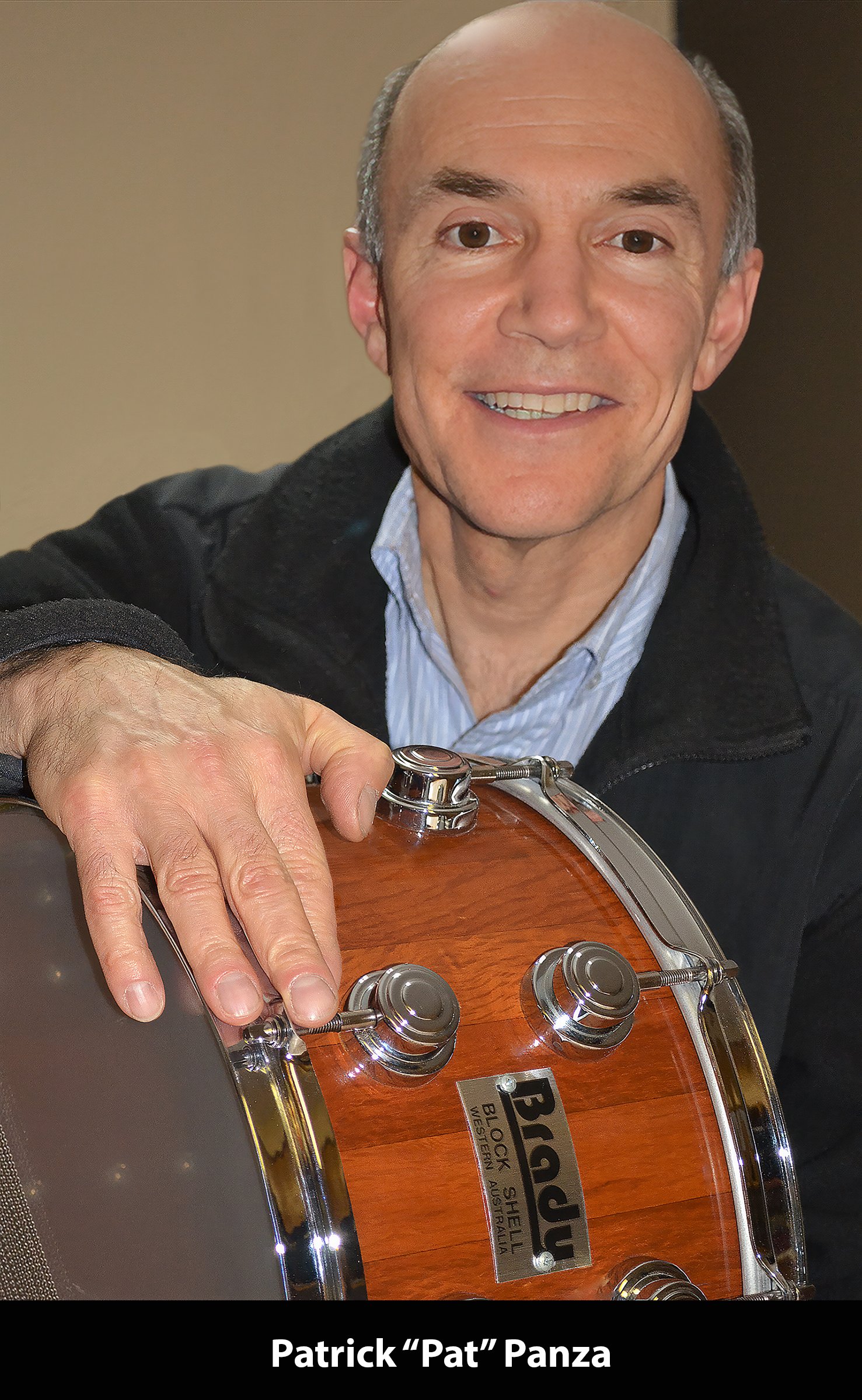Brady Drums, made by Chris Brady and company, are revered worldwide for their fine craftsmanship, exotic Australian timbers, and most notably their wonderful and unique sound. Chris Brady, truly a drum building pioneer, introduced Jarrah, Sheoak, Wandoo, SpottedGum, and other indigenous Australian woods into the vocabulary of drummers. Brady constructed these drums with ply, stave/block, and even solid shells.While Brady Drums began around 1980, they exploded onto the music scene around 1991. TheSpin Doctors had released an album, “Pocket Full of Kryptonite”, with an amazing drum intro and beat by drummer, Aaron Comess. Just about every drummer was asking, “what was that snare drum?”. The drum sounded incredible, and certainly Aaron brought out the best in it. The snare drum was later revealed to be a 4.5 X 14” Brady Jarrah ply shell snare, a drum which Aaron still has in his arsenal to this day.
Brady drums had certainly been popular with A-list drummers like Jeff Porcaro, Jim Keltner, Larry Mullen, Dony Wynn, and others. However, these drums were largely used in the studio, so Brady had not yet perhaps received the public attention it deserved. After Aaron Comess shared the identity of his beloved snare drum, Brady became a household name and is highly regarded as one of the premier drum companies.
On November 25, 2015, Brady Drums formally announced they were ceasing operations due to ongoing serious health issues with their founder and master craftsman, Chris Brady. This was a sad day for the drum community, knowing that no new Brady drums would be produced. However, all wished Chris the best of health and hoped he would recover. Subsequently, the desire and value of Brady drums steadily increased as they were now limited in number.
Every Drum Tells a Story: I have long been a fan of Chris Brady’s drums, as they possess an unparalleled sound and character like no other. It has often been said, “Nothing sounds like a Brady.” I can attest to the truth of that statement. I’ve been fortunate to experience first-hand the sonic and visual beauty of many of these Australian timbers, including all of those noted above. Of these, Sheoak has long been a particular favorite.While browsing the Brady Drum Fanatics group on Facebook, I was fortunate to come across a post by Patrick Panza, a drummer from Canada. The drum pictured was a 7 x 14” Brady Sheoak block snare, but it had single post DW turret lugs (10 top and bottom) and DW throw-off/butt plate. I wondered if this was an after-market alteration (heresy LOL!) or some early experimentation by Chris Brady. After some online discussions with Kelly Amoroso (Chris Brady’s daughter) and Patrick, it was confirmed that this was indeed a custom snare built for Patrick in1984 using DW hardware. Kelly presumed that this was due to “a complete lack of hardware options in Perth, Australia, at the time...Dad was building (drums) only out of his garage at that time, while holding down a regular job and playing in bands at night.”
To put this into a historical perspective, this was one of Chris Brady’s very early block drums. He had only begun making block drums around 1982. Don Lombardi of DrumWorkshop (DW) purchased the Camco machinery, dies, and molds around 1979. DW then started producing the Camco turret lugs (originally invented by George Way many years previously) which were used on this Brady Sheoak block snare.This combination of DW hardware and Brady Drums cam together in 1984 when both companies were still quite young.
Patrick“Pat” Panza was kind enough to share the wonderful and detailed story of how he met Chris Brady and came to obtain this amazing drum: PatPanza: “I first visited Australia in 1982, as part of a one-year backpacking adventure from Toronto, Canada to the USA and on to Australia and S.E. Asia, a marvelous adventure. In 1984 I returned to Perth, WA, to live there for six months and see if I wanted to stay there permanently. Fortunately, I had a place to stay in Bassendean, a suburb of Perth. I immediately started looking for a band and met Luiz Carlos, a very talented pianist, had an audition, and got the gig. It was a small five-piece band, and we played a mixture of pop and jazz.I had purchased a used set of Premier Olympic drums without cymbals, so I visited a local store, Concept Music, to see about renting cymbals for our upcoming gig. (we were booked every Friday night at Pier 21 in Fremantle). At the store, I explained my situation to the salesman and in the middle of our conversation he had to take a call, and this is when serendipity entered the moment. I began browsing around the store and this fellow walks up to me and says,‘Hi, I’m ChrisBrady, I overheard your conversation, you don’t have to rent cymbals mate, I’ll lend you some cymbals. ’Imagine that! Someone you never met offering to lend you an instrument without hesitation. Chris knew of Luiz and figured if I was playing with him, I was a decent player and wouldn’t destroy his cymbals!
Over the next couple of months, I got acquainted with Chris and saw his workshop and learned of his drum making skill and was amazed that he was hollowing out tree trunks to create a seamless one-piece shell, a very innovative idea. He showed me the Australian hardwoods he was using such as Jarrah, Sheoak, and Wandoo, each having a different timbre and natural, beautiful grain. I lived in Perth for six months and then returned to Toronto, in the fall of 1984. I kept in touch with Chris and when he told me he was going to the states and would be in New York, I asked him to bring me a snare. We met in N.Y.C., and I picked up my snare–an amazing Sheoak stave, (block), fitted with large DW (Camco) lugs and DW dual tension adjustment. It sounded fantastic. I’m not a scientist but I’m convinced that the thick Sheoak shell combined with the large, round lugs creates an outstanding snare sound. At the time I played a 1970’s Gretsch kit and the combination was fantastic.
Unfortunately, my drums were stolen from a church but not the snare-I always took the Brady and my cymbals home! On a deeper personal level, this drum is part of my story and I have wrestled for a while about selling it and moving on to a different snare. After thirty-nine years of playing part time with this drum, I finally decided to sell it and I’m happy to say it’s in good hands where it is appreciated, as it should be! I feel very fortunate that I met Chris in that music store many years ago. He is a true artisan,and his craftsmanship has inspired countless drummers to bring their best to their performance. Thank you, Mr. Brady. Good onya, mate!”
Post-script-Some additional details which I believe make the story even more interesting: Kelly mentioned that she believed it was “just happenstance that Dad was visiting this music store (Concept Music) at the same time Pat was there...” In my opinion,what an amazing stroke of fate! In addition, Pat later mentioned to me that he ordered the drum sight unseen; he had no idea how the drum was to be constructed, and it was a complete surprise when he was given the Sheoak drum by Chris.
Fit/Finish and Sound: For those curious, the snare drum arrived in immaculate condition (thankyou, Pat!) with triple flange hoops, the DW hardware mentioned previously, Puresound snare wires, Remo Ambassador heads, and a rectangular badge, “Brady block shell, Western Australia”. Consistent with early Brady drums, there was no serial number on the inside of the shell. My first impression was that this drum was quite heavy, not surprising due to the installation of 20 turret lugs on the shell vs. the later Brady tube lugs. That being said, it sounded phenomenal with that authoritative Brady bark and low-end throatiness. Presumably due to the significant mass of hardware on the shell, this particular drum seemed a little less resonant than my other Brady snares with tube lugs. This was not necessarily bad, just different-more focused and with more attack. I was not disappointed and delighted to add to this to my drum arsenal. Closing Thoughts: As you might expect given the wonderful origin story and construction of this drum, I was quite excited to add it to my collection. I was immensely thankful that Patrick allowed me to be the next caretaker of this drum. I felt it was tremendously important to share the history of this particular Brady snare, as I know this drum will outlive me, Pat, and Chris. I hope that it will be equally appreciated and revered by others and the story will continue.
Acknowledgements: My very sincere thanks to Pat Panza for sharing his story, and to Kelly (Brady) Amoroso for providing additional background info and anecdotes from her Dad. Kelly has truly been the “keeper of the flame” for Brady, generously sharing her knowledge of BradyDrums, authenticating and maintaining a database of Brady Drums, and helping keep the Brady name alive in the hearts of drummers worldwide. Special thanks to Chris Brady for his creativity,genius, unabashed enthusiasm for drum craftsmanship, and for introducing the world to exceptional Australian wood drums.

